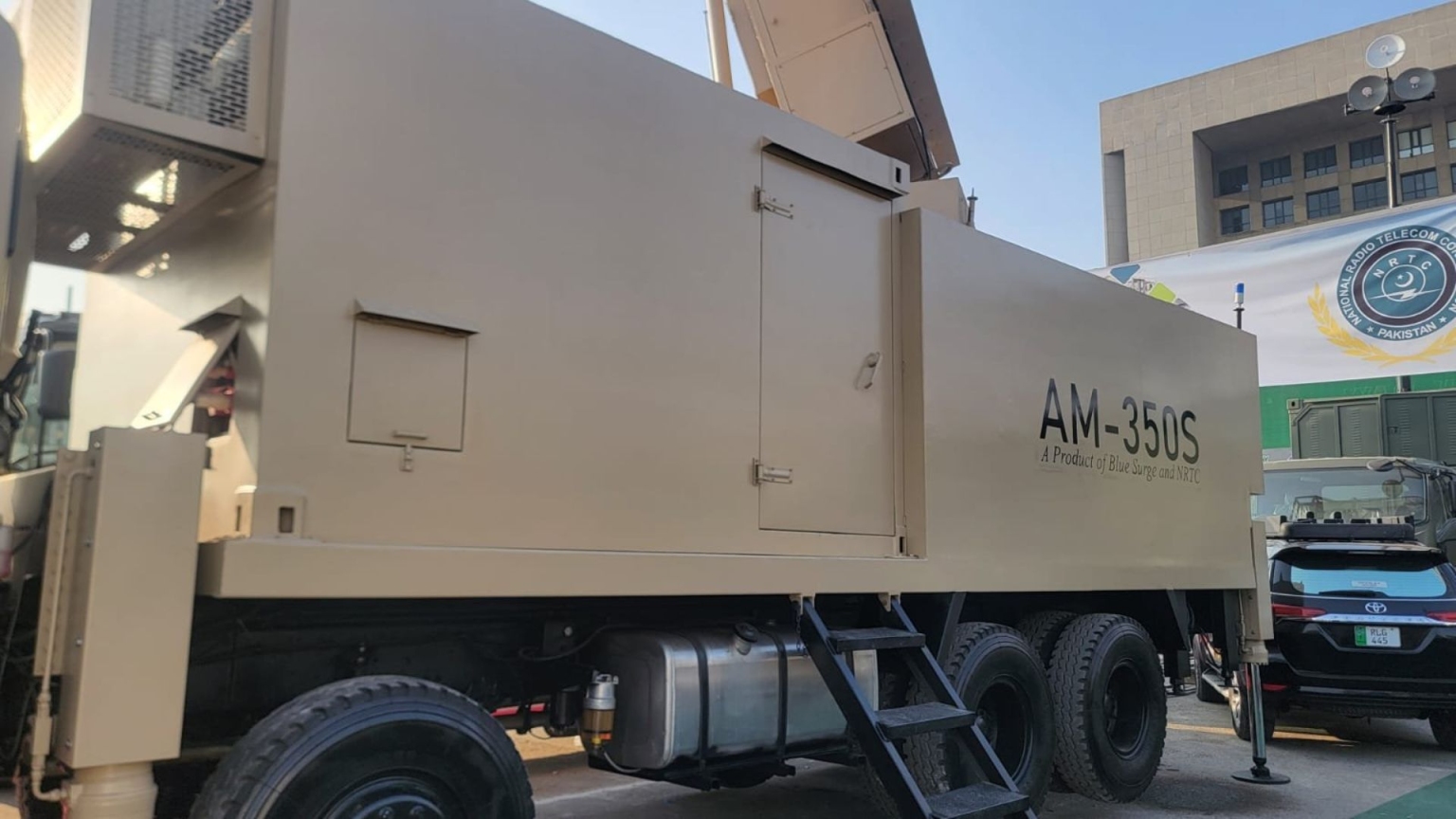
Source: Quwa.org
Awais Raoof
Pakistan’s unveiling of the AM-350S long-range 3D air surveillance radar at the IDEAS 2024 defense exhibition marks a significant leap in the country’s quest for self-reliance in defense technology. Developed collaboratively by the National Radio and Telecommunication Corporation (NRTC) and Blue Surge (Pvt Ltd), the AM-350S embodies Pakistan’s ambition to reduce its reliance on foreign defense imports while addressing the dynamic security challenges in South Asia. This radar is not just a response to existing threats; it is an effort to reclaim strategic autonomy. In a region where operational independence often determines success in conflict, this system reinforces Pakistan’s ability to control how and when its airspace is defended, free from the political or logistical constraints of foreign procurement.
Historical Evolution of Pakistan’s Air Defense Systems
Pakistan’s journey in developing robust air defense systems has been shaped by a combination of necessity and external pressures. In the early decades, the country relied heavily on imported radar systems, such as the AN/TPS-43 and AN/TPS-77, to monitor its airspace. These systems were critical during the Cold War and in subsequent conflicts with India, providing Pakistan with vital early warning capabilities.
However, the imposition of sanctions in the 1990s, particularly after Pakistan’s nuclear tests, exposed the vulnerabilities of relying on external suppliers. This period marked the beginning of an indigenization drive, with institutions like NRTC playing a pivotal role in developing homegrown solutions. The AM-350S is a culmination of this effort, representing decades of investment in research, development, and collaboration between the public and private sectors.
The AM-350S radar is a state-of-the-art system that incorporates advanced technologies to meet modern air defense requirements:
Technological Features of the AM-350S
- Detection Range: With a maximum range of 350 km and the ability to track high-speed targets at altitudes up to 60,000 feet, the radar can monitor a wide variety of threats, from fighter jets to small UAVs.
- Gallium-Nitride (GaN) Technology: Its use of GaN-based Transmit-Receive Modules (TRMs) ensures higher efficiency, resilience, and durability compared to older systems.
- Advanced Signal Processing: Equipped with an active electronically scanned array (AESA) and digital beamforming, the radar offers exceptional precision and resistance to electronic countermeasures.
- Mobility: Mounted on a truck platform, the AM-350S can be rapidly deployed and repositioned to respond to evolving threats.
These features not only enhance Pakistan’s airspace monitoring capabilities but also position the AM-350S as a competitive system compared to regional counterparts.
Strategic Benefits of the AM-350S
Amplifying Deterrence Beyond Conventional Metrics
Air surveillance is the backbone of deterrence, not only in tracking incoming threats but also in establishing credibility through consistent situational awareness. The AM-350S strengthens Pakistan’s ability to sustain credible deterrence on two levels:
- Conventional Defense Layer: By enhancing the detection and tracking of high-value aerial targets, the radar can integrate with Pakistan’s existing Surface-to-Air Missile (SAM) systems like LY-80, creating a layered air defense architecture. This ensures Pakistan’s ability to contest air superiority in a potential conflict scenario with India.
- Strategic Signaling Layer: The system communicates a message of resilience and preparedness to India, signaling that advancements in Indian air or missile defense systems will be met with corresponding upgrades in Pakistan’s detection and response capabilities.
The radar’s integration with command-and-control networks will also allow for better response coordination across the country, a critical component in minimizing the risk of miscalculation or escalation during crises.
A Counterweight to India’s Advancements in Force Multipliers
India’s rapid modernization of its air defense capabilities poses a direct challenge to Pakistan’s security. Advanced systems like India’s Swordfish Radar (central to its Ballistic Missile Defense program) and its Netra AEW&C airborne platform represent a growing technological gap in the region. The AM-350S steps into this equation as a vital counterbalance.
One of its standout features is its ability to track small UAVs at ranges up to 80 km—critical in an era where drones have shifted from surveillance tools to frontline combat assets. This is particularly significant given India’s growing use of UAVs along the Line of Control (LoC), both for reconnaissance and precision strikes. Similarly, the radar’s advanced signal processing makes it an effective counter to India’s hypersonic ambitions, offering Pakistan the ability to detect and monitor high-speed threats in real-time.
Rather than allowing this technological gap to widen, Pakistan has leveraged the AM-350S to narrow it, ensuring that its defenses keep pace with India’s force multipliers.
Bridging the Asymmetry in Electronic Warfare
One of the most understated but critical features of the AM-350S is its resilience in electronic warfare (EW). India’s growing investment in jamming technologies and electronic countermeasures presents a direct challenge to radar networks across the border. Systems like the AM-350S, with anti-jamming capabilities such as frequency hopping and sidelobe suppression, provide Pakistan with a reliable defense against such tactics.
This resilience extends to its modular hardware design, allowing on-site repairs to damaged components during conflict—a feature often overlooked but invaluable in ensuring operational continuity. These technical details translate into broader strategic value: the assurance that Pakistan’s air defense will not be compromised during high-stakes engagements.
Regional Security and Shaping the Strategic Environment
While the AM-350S is understandably viewed through the lens of Indo-Pak rivalry, its implications go beyond bilateral concerns. For Pakistan, the development of such an advanced radar sends a broader message to allies and adversaries alike: the country is not merely a consumer of defense technology but a capable innovator in its own right.
Shifting from Reactionary to Proactive Security
Historically, Pakistan’s defense policies have been reactive, shaped by the need to respond to Indian advancements or crises. The AM-350S, however, signals a departure from this pattern. By investing in high-end air surveillance, Pakistan is anticipating future threats, positioning itself as a state that acts with foresight rather than one that reacts under pressure.
This shift is particularly evident in the radar’s ability to provide pre-crisis utility. Its rapid deployment capabilities allow it to secure critical zones—such as those near the LoC or along CPEC routes—well before tensions escalate. In a crisis scenario, this means decision-makers have the tools and intelligence they need to act decisively, avoiding miscalculated risks or delays.
Redefining Deterrence with the AM-350S
The AM-350S is not just a radar—it is a strategic statement. By bridging technological gaps, countering adversarial advancements, and building resilience into its air defense architecture, Pakistan has demonstrated that it is serious about securing its airspace on its terms.
What sets the AM-350S apart is its blend of operational sophistication and strategic foresight. It is not a reaction to India’s capabilities but a proactive tool designed to ensure Pakistan remains a credible player in South Asia’s security architecture. As the system becomes operational, it will redefine how Pakistan manages both its immediate security needs and its long-term strategic objectives.
Awais Raoof is the Director, Shareholder of Blue Surge Pvt Ltd, co-developer of AM-350S with NRTC. He is also the editor-in-chief of Pakistan Politico and Chairman BoG, University of Lahore.







